2 new “standalone” 7-inch MFDs: Simrad Go7 and B&G Vulcan V7
The brand new Simrad Go7 looks like an all-glass version of the Simrad NSS7 evo2 Combo, but its design may actually define an interesting new “standalone” glass bridge MFD style that trades some of the multi in multifunction for a much lower cost. The Go7’s suggested retail price is just $799 without charts or transducer, and its B&G Vulcan V7 sibling is also just $799 with an added bundle of sailing features. I put “standalone” in quotes — and we need a better term — because these chartplotter/sonar combos can make many useful connections over NMEA 2000 and WiFi, though they do not include the Ethernet needed to fully network with radars, other MFDs, and external sonar sources…
I got to see Go7 and Vulcan V7 prototypes in action during Navico’s press event in January, and the simple three-port backside above says a lot about how they cut manufacturing costs. Missing is not only an Ethernet connection, but also video inputs and NMEA 0183 ports for legacy sensors. And while the NSS evo2 Combo MFDs have one sonar port that can handle a variety of CHIRP fishfinder transducers and another for StructureScan/DownScan or ForwardScan, all networkable around a boat, the Go7 has a single port designed for Navico HDI combination CHIRP/DownScan transducers like the Lowrance transom and thru-hull HDI models seen here. Note, too, the rear SD card slot, which makes the front side at least cleaner and probably easier to build, but also means that panel mounting requires an optional $30 frame kit that may ease card access. (Then again, a Go7 or V7 owner can use the built-in GoFree WiFi online feature I also saw in January to download charts and firmware updates and upload user data without touching the card.)
The front is a different story. The product image above may be photoshopped (the 2.0v battery state is a clue 😉 but the Go7/V7 screen has the same nice specs as the NSS evo2 and Zeus2 7-inch models: 800 x 480 multi-touch pixels with 1200 nits of bright LED backlighting. I also have the Go7 manuals and don’t notice any feature of NSS evo2 that’s missing in the Go7 except for the already mentioned items like radar, video, and NMEA 0183. The main panel above, for instance, shows the neat Nav mode — an elaborate “rolling road” screen — that came with evo2, and you can split the display into 2, 3, or even four variable size panels plus the databar. Note the databar’s autopilot pop-up, which can also be a panel, and know that besides full AP support, the Go7 and V7 can use NMEA 2000 to interface with Fusion or Simrad audio, CZone digital switching and monitoring, and either Mercury VesselView or generic NMEA 2000 engine info. Of course, they can also display more conventional N2K data in myriad ways, and at least the Vulcan can fill the whole screen with one numeric value (or 2, 3 or 4). At $799, this 7-inch “standalone” is like a big IS40 (Triton) all-in-one N2K instrument display with a whole lot of extras thrown in!
I can picture the Go7 or Vulcan V7 being used either as a standalone primary navigation system on a smaller boat or a nice accessory screen to a bigger boat system, but Simrad is emphasizing the former in its go-go Go7 video while B&G demonstrated the Vulcan in Florida on a sleek Beneteau Oceanis 55. You can see above what a regular chart screen looks like and the relative compactness of these glass displays compared to a big HS35 wireless handset (whose base RS35 VHF is also networked to the V7). Sailors will like the V7’s maximum 1 amp current draw (at 13.6v with sonar off), and anyone considering a Go7 or V7 might like to add an OP40 keypad for when touch controls are hard. I wouldn’t be surprised to see smaller, less expensive N2K keypad options eventually, and these MFDs also have Bluetooth, which makes wireless remotes also a possibility.
The Vulcan 7 also introduces the SailSteer Overlay seen above, though I believe it will be coming to other B&G MFDs in a firmware update. Note the Sailing Time tack distances and ETA’s on the databar and that the more familiar full panel SailSteer graphic is also available.
In fact, the SailSteer graphic has been improved since I first saw it in Las Palmas, and the Vulcan also seems to fufill the promise made there that B&G sailing aids would become more available to sailors on a budget.
But Vulcan can also have a relationship with B&G’s higher end gear. I hesitate to show this picture because the feature is not mentioned at all on the current Vulcan V7 product page, but full integration with the H5000 instrument system is definitely in the works. What’s also not mentioned on those Vulcan pages (except for the specs) is sonar, but I’ve confirmed that the V7 has the same CHIRP and DownScan capabilities as the Simrad Go7. In fact, the Vulcan press release mentions “a unique perspective on what’s beneath the boat, thanks to Cruise Sonar – a picture-like representation of bottom structure”…but I’m not sure if that’s different than the DownScan image below. I’m sure there’s more to learn about the Vulcan V7 and Go7, but so far I think they look great as long as the user understands what they can and cannot do. What do you think, and what’s a better term for this MFD design than “standalone”?


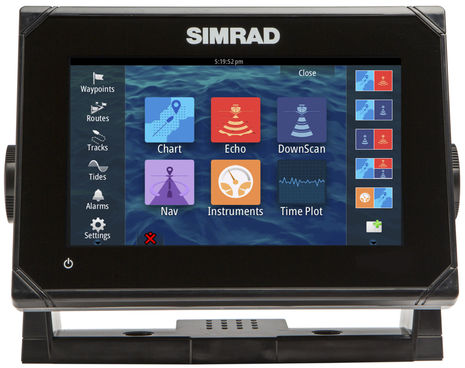
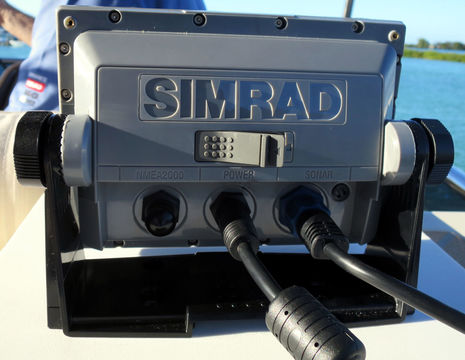
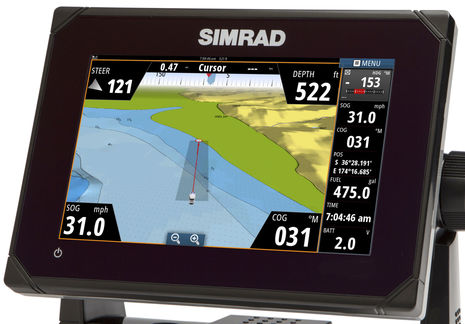
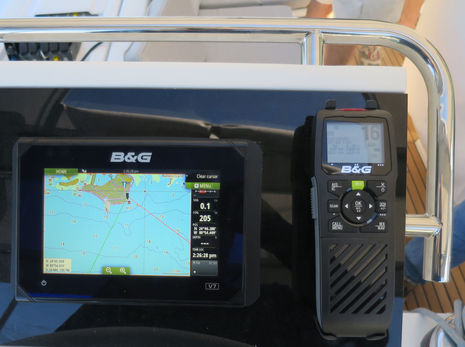

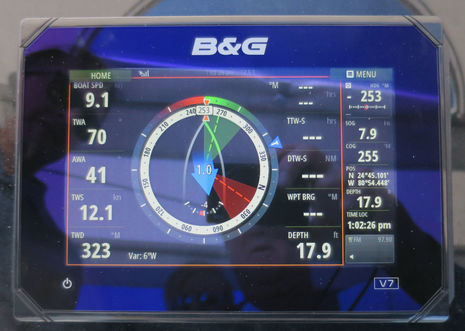
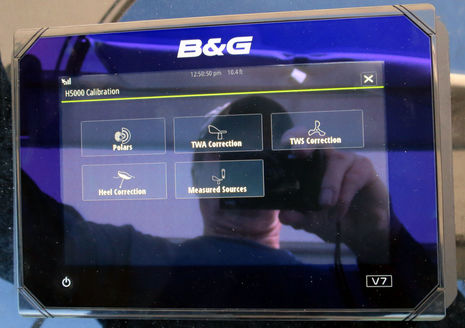
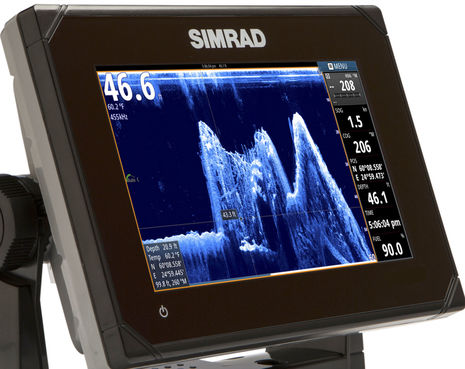











First impressions are good, apart from the lack of radar support. Page 88 of the Operator manual shows a nice user interface to support making DSC calls to an AIS target over NMEA 2000, complete with a change channel option. Not only that, it uses the standard N2K PGN 129808 so it works across brands.
NMEA 2000 using standard connectors and no NMEA 0183 connections!
Wow. I predict that B&G Vulcan will be a big draw for sailors. The sail specific functionality is very attractive, and the lack of radar support won’t be an issue for most.(Although, I suppose radar and sirius weather could be added via WiFi ?)
This was a very interesting — and maybe unresolved — conversation about direct DSC calls to AIS targets using NMEA 2000, but it’s way off the topic of Go7 and V7 “standalone” MFDs so I moved it to the Forum:
https://panbo.com/forum/2015/04/direct-dsc-vhf-calls-to-ais-targets-a-nmea-2000-standard.html
hi, wondering if forward scan would would with unit?
Good question, Mark, and one I meant to address.
But the answer I’m afraid is NO.
Navico told me that the Go7 and Vulcan V7 support “any Simrad/B&G blue 7-pin connector transducer” which does not include the black 9-pin StructureScan and ForwardScan transducers.
It’s a little confusing because normally DownScan comes with StructureScan over the 9-pin port but Navico has some special HDI transducers that can do both CHIRP sonar and DownScan over the 7-pin cable. Here’s an example of the Go7 bundled with an HDI transom ducer for $849:
http://www.starmarinedepot.com/simrad-go7-7%22-multi-touch-chartplotter-with-hdi-transducer/psm1100-015.html
Dan brings up an interesting point. These little fellows have WiFi built in, so if you have your existing MFDs on a WiFi network then maybe they would do chart/sonar sharing, and even radar in a pinch?
That would be interesting to test if someone gets their hand on one and can put it in a bigger network. I’m looking at you here, Ben!
Actually, what i was thinking, is if Simrad offered a radar with built in wi-fi output like Furuno’s …
https://panbo.com/archives/2014/12/nobeltec_timezero_app_2015_furuno_drs4w_wifi_radar_overlay_more.html
.. then the Go7 and Vulcan V7, could become fully capable chartplotters with radar, despite not having an ethernet port.
I will upgrade my Silva Star log, sonar and wind instruments to models that output NMEA data. Instead of buying two B&G triton displays I am now considering getting one Vulcan. I already have a Zeus Touch plotter installed on my boat.
So, does the Vulcan come with any charts built-in?
If so, I’ll be buying the European version of it as soon as we make landfall in Ireland in about five weeks from today.
Xavier, here’s the word on SKU’s (stock keeping units) from Navico:
“GO7 is $799.00 in the SKU with no transducer included. GO7 has two other SKUs, one with the HDI 83/200/455/800 kHz transom transducer at $849.00 and the last SKU also includes the Navionics+ (formerly “Gold”) mapping card and a HDI 83/200/455/800 kHz transom transducer at $949.00. Vulcan 7 has only one SKU, it is with no transducer included and like GO7 is $799.”
So the Vulcan V7 comes chartless, but you’ll sure have a lot to choose from. Check out the GoFree Shop:
https://www.gofreeshop.com/
“Sailors will like the V7’s maximum 1 amp current draw (at 13.6v with sonar off)”
Is that good ? Garmin 721 draw 0.6A
RP, where did you get a “0.6A” draw for a Garmin 721?
Here’s what Garmin says:
“Max power usage at 10 Vdc: 27 W
Typical current draw at 12 Vdc: 1.3 A
Max current draw at 12 Vdc: 2.3 A”
https://buy.garmin.com/en-GB/GB/marine/chartplotters/gpsmap-721/prod119864.html
Strömförbrukning: 0,6 A vid 12 V; 0,3 A vid 24 V
0,8 A vid 12 V; 0,4 A vid 24 V (med ekolod)
All swedish web marine shop say 0.6A
I have also read test that say 0.6A
Maybe someone here Who owns a garmin 721 know?
But perheps vulcan typical draw 0.6A also and Max 1A ???
I looked at the Swedish Garmin web pages for the 721 — those specs are not for the 721. Thanks to Google, I did find a match on that website, but it was for the GPSMAP 527, a smaller unit with a black and white screen (and about which the US Garmin website has no information).
Thanks, Norse, but here’s the Garmin 527 product page… http://goo.gl/QqdEa3 …and it doesn’t seem relevant.
There’s definitely something being lost in translation, though, and I tend to believe that Garmin’s 721 power specifications in English are correct. The good thing is that I can test next week on 741 with sonar off. Let’s please let it go until then.
Is it possible to integrate a B&G Vulcan Plotter into a Raymarine SeatalkNG Backbone with Log, Speed and temp, Wind sensors (Tridata package) connected to an Raymarine i70 ?
I found out that Raymarine sells an adapter cable to convert the SeatalkNG to NMEA2000. So hardware connectivity should not be an issue. What about the functionality on the software side. Will the Vulcan display the laylines based on the sensors of the Raymarine Tridata package ?
Who has tested this already ?
This will work just fine. Seatalk NG is just Ryamarine’s NMEA2000 cabling. I guess the only thing that might be different is some of the calibration? But you can do that from the i70 I guess
Thinking about these on both sides of the wheel, in addition to Zeus2 and PC in the Nav, 2xGraphic displays, 4×20/20’s on the maat, H5000 Hercules. Only thing is the lack of Ethernet and chart replication, need to buy charts for each unit…
Great info, thanks!
How does the Vulcan 7 software account for different types of sailing vessels, ex. catboat, gaff rigged sloop, & etc. ?
Wondered if one can rotate the screen, i.o.t make vertical installation on the side of a pedestal and display numerical data/info on top of each? Or display the chart vertically (like ipad screen)?
I Installed the Vulcan inside the wheelhouse of my Motorsailer where it is nice and safe, and planned to use my Ipad,in a lifeproof case mounted at the outdoor helm.. I have done this, but it is not the ideal set up I hoped it would be…. prior to installing the Vulcan I have been using the ipad for a while, with Navionics App and have fallen in love with having so much information at the helm. Since the GO Free is Wifi, once connected the ipad no longer has 4G access, therefore it is real effort if you want to use the ipad to check the weather/tides or anything else, would have been much better if it connected via BLUETOOTH.
So,the APP itself, has a few shortcomings. First thing I noticed, is that it only works in Landscape, not Portrait, which is my preference….. but hey that’s a personal preference.(the Vulcan only works in Landscape)
A big drawback, is that every time you switch between Apps, you have to reconnect to the Vulcan, since it disconnects as soon as you move to another App.
Navico, made the decision that you cannot control the Autopilot from the ipad…. and that’s their prerogative, but I don’t understand why?…. it would be SOO much better if you could….. I thought I had got around this by installing the WR10 wireless remote control…. and I have to an extent, but the WR10 is limited to 2 modes, heading hold and wind mode, the Autopilot has a host of other modes, but you have to go to the Vulcan itself to activate them…. most noticeably NAV mode.
The Ipad replicates exactly what is on the VULCAN display, and whatever you change on the ipad display, will change on the Vulcan….. so you cannot use the Ipad, as an extra display to show a different Screen from the Vulcan, I guess that’s what it is for, but I think it’s a wasted opportunity.
Most Frustratingly of all, since you are not allowed to operate the Autopilot from the ipad, any time you access a screen that controls the Autopilot, it just Locks up… you can’t even leave that screen, until you go back to the Vulcan, it takes a while to work out exactly what will lock it all up, since you can lock it up from various screens, not just by selecting the Autopilot Screen.
It was a long shot, but I was hoping the Go-Free network would be Wi-fiing the NMEA sentences that could be used by third party APPS, but alas no.
SO overall, the Go-Free App is Good, but it could be EXCELLENT with a few changes. I think I will be moving the Vulcan to the outside Helm position, and keeping the ipad there too……
It looks like B&G might have discontinued the Vulcan line, or at least they might be getting ready to come out with something new and not promoting it anymore. I went into a local West Marine to purchase one, and they don’t have any more stock, have notes from B&G to remove store models, and have discontinued it in West Marine inventory. That’s usually a sign of something going on…
Vulcan is definitely not discontinued, Steve, but there is a new Vulcan 7 FS model that directly supports a ForwardScan transducer, which I think significant. I mentioned it here…
https://panbo.com/archives/2016/01/tbf_icom_m93d_garmin_quatix_3_gnx_wind_imtra_largo_led_and_navico_makes_forwardscan_more_accessible_.html
…but didn’t get to see one in action at the recent Navico writer’s event. I did get to see the Simrad version of the new 5-inch models that have joined this family of displays and though it doesn’t support FS, it seems a notably able plotter/fishfinder/N2K display for this size and price.
http://www.bandg.com/en-US/Product-Groups/Vulcan/
Strange…. it’s still on the banner of the B&G home page…… maybe they read my appraisal and thought they better raise their game!!
Today’s new Simrad GO9 XSE is good news, I think, but possibly confusing. Unlike the GO7 and GO5, the GO9 has Ethernet, but it’s only for radar, not networking with other MFDs, black box sonars, etc. But it also has three kinds of sonar processing built right in and lots more:
http://www.simrad-yachting.com/en-US/Products/GO-series/#products
…and today B&G rolled out the the Vulcan 9, which seems to be the same hardware as the Simrad GO9 but with SailSteer and other sailing features:
http://www.bandg.com/en-US/Products/Vulcan-9/
Ik ben in bezit van een b&g vulcan 7. Nu heeft mijn stuurautomaat het begeven…..
Welk onderdeks stuurautomaat adviseren jullie..
b&g of raymarine ??????
Hoor verschillende verhalen……
Hi Andre,
I think Google Translate did well with your question:
“I am in possession of a b & g vulcan 7. Now my autopilot has it go …..
Which lower deck autopilot advise you ..
b & g or raymarine ??????
Hear different stories ……”
The reputations of autopilot similar to those of boat batteries, I think: There are lots of strong opinions but hardly anyone has actually used two or more types on same boat in same circumstances.
That said, I suspect that all modern autopilots perform decently if installed correctly, but often there are bonus features if you use the same brand as your MFD.
That’s certainly true of the Simrad ap I use and the Simrad NSS evo2 MFDs on my boat. I don’t even use a regular AP control head anymore because all the functions can be done on the MFDs, including deep calibration and setup. I do have an AP keypad for quick course adjustments etc. but it’s not necessary.
I suggest you check your Vulcan 7 manual to see what the 7 can do with B&G autopilots on the same NMEA 2000 network.
Hi André, you’re lucky there are Dutch speaking people here that can understand what you are asking…
For everyone else — his question is:
I own a B&G Vulcan 7. My autopilot is broken. Which below-decks autopilot do you you recommend? B&G or Raymarine? I have heard of varying experience(s).
I think both produce excellent autopilots, and that most experiences reflect more on the installation and the installer than anything else. If you get an installer to do it make sure he is experienced with the brand you have selected.
With that said, if you get a B&G autopilot you will be able to control it from you Vulcan. Depending on your setup you will either have a free extra control station or won’t have to buy a control display.
You can also buy a Simrad branded AP, they are interchangeable within Navico. I control my Simrad AC42 from my B&G Zeus…
Just had my Raymarine C80 die. Looking at a b and g chart plotter. Have an ST control head that is seatalk ng and everything else is nmea 183 and seatlk. Can I make this fit in and talk?
Sorry I missed this, Deb, and maybe you already learned that any NMEA 2000 standard data like Heading that’s being seen by your STng AP head should network fine to current B&G plotters or most any other display with N2K.
While there are a number of Go 5 units available, it seems that B&G/Navico pulled the 5″ Vulcans from the market. Problems or too many configurations to support?
Peter, I don’t know why B&G dropped the Vulcan5, but I bought a very similar GO 5 last fall and it works fine. I also just came across another use of what looks like the same basic system:
http://www.czone.net/en/80-911-0124-00
Note that Simrad recently introduced a Cruise series that are even less expensive, and have buttons instead touch, which I’d prefer at 5-inch size. But they have no N2K, WiFi, Ethernet etc so its hard to see how B&G could add their sailing screens:
https://panbo.com/new-simrad-cruise-is-the-most-intuitive-and-easy-to-use-chartpolotter-available/